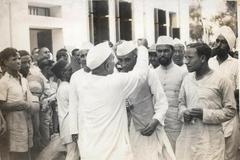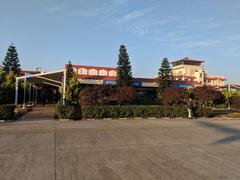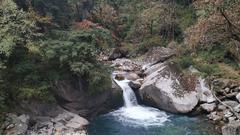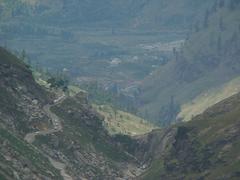
Karcham Wangtoo Hydroelectric Plant: Visiting Hours, Tickets, and Travel Guide
Date: 04/07/2025
Introduction
Set amidst the dramatic peaks of Himachal Pradesh’s Kinnaur district, the Karcham Wangtoo Hydroelectric Plant is a landmark of India’s sustainable energy ambitions and a testament to modern engineering. Built on the Sutlej River between the villages of Karcham and Wangtoo, this facility is a major contributor to the northern power grid, boasting an installed capacity of up to 1,200 MW. Since its commissioning in 2011, the plant has become not only a model of renewable energy infrastructure but also a point of interest for travelers, students, and engineering enthusiasts.
This detailed guide provides essential information on the Karcham Wangtoo Hydroelectric Plant’s history, technical features, visiting procedures, travel logistics, nearby cultural attractions, and practical tips for an enjoyable trip. Whether you are interested in hydropower, Himalayan landscapes, or Kinnauri culture, this article will help you plan your visit. For further details and updates, explore the Wikipedia page on Karcham Wangtoo Hydroelectric Plant and the Power Technology profile.
Table of Contents
- Historical Background and Development
- Visiting Information
- Technical Specifications
- Travel Logistics and Accessibility
- Nearby Attractions
- Cultural and Environmental Context
- Frequently Asked Questions (FAQ)
- Practical Travel Tips
- Conclusion
- References
Historical Background and Development
Conceptualization and Construction
The idea for the Karcham Wangtoo Hydroelectric Plant emerged in the early 1990s as India sought to harness Himalayan rivers for renewable energy (Wikipedia). In 1993, the project was formalized through a memorandum of understanding between the Himachal Pradesh government and Jaypee Karcham Hydro Corporation Limited (tamizha.net). The remote and geologically sensitive terrain presented challenges such as land acquisition, environmental clearances, and transportation.
Construction started in November 2005, with the plant designed as a run-of-the-river scheme to minimize reservoir creation and environmental impact (Scribd). Major engineering highlights include a 43-meter-high concrete gravity dam, a 17.2-kilometer headrace tunnel, and an underground powerhouse equipped with four 250 MW Francis turbines (Power Technology).
Commissioning and Ownership
Between May and September 2011, the plant’s generators were commissioned, providing electricity to multiple northern states (Wikipedia). Ownership transitioned from Jaiprakash Power Ventures to the JSW Group in 2015, marking a significant move in India’s hydropower sector (JSW Energy).
Environmental and Social Considerations
The project, while vital for clean energy, has prompted environmental and social debates regarding deforestation, river ecology, and community displacement. Mitigation measures include afforestation programs and increased community engagement, though environmental concerns persist (The Diplomat).
Visiting Information
Hours and Access
- Public Entry: General entry to the plant is restricted for operational and security reasons.
- Guided Tours: Educational and technical group tours may be arranged by advance application through JSW Energy. These require prior approval and submission of valid ID.
- Viewpoints: The dam and powerhouse can be viewed from designated vantage points along the main highway and from nearby villages during daylight hours, typically 8:00 AM to 6:00 PM.
Tickets and Permits
- Tickets: No ticketing system exists for casual visitors. Any organized group tours must be pre-approved.
- Permits: Indian nationals do not require special permits. Foreign nationals must obtain an Inner Line Permit (ILP), available online or at SDM offices in Shimla, Reckong Peo, or Kaza.
Technical Specifications
| Feature | Specification |
|---|---|
| Installed Capacity | 1,000–1,200 MW (4 × 250 MW Francis turbines) |
| Dam Height | 43 meters (concrete gravity dam) |
| Headrace Tunnel | 17.2 km length, 10.48 m diameter |
| Powerhouse | Underground, near Wangtoo |
| Tailrace Tunnel | 909 meters long |
| Annual Generation | ~4,560 million units (GWh) |
| Penstocks | Four, 290.5 m long, 4.75 m diameter |
| Commissioned | 2011 |
| Operator | JSW Energy |
References: Wikipedia, Power Technology, Voith Hydro Project Fact Sheet
Travel Logistics and Accessibility
Getting There
- By Road: Accessible via National Highway 5 (Hindustan-Tibet Road) from Shimla through Narkanda, Rampur, and Tapri. The drive is scenic but challenging, taking 8–10 hours.
- By Public Transport: HRTC buses ply between Shimla and Reckong Peo, with local taxis or buses available for the final stretch.
- By Rail/Air: The nearest railhead is Kalka, and the closest airport is Shimla (Jubbarhatti Airport), approximately 150–200 km away.
Road Conditions
Expect narrow, winding roads—especially difficult during monsoon and winter. Landslides and road closures can occur; always check current conditions before travel.
Nearby Attractions
- Sangla Valley: Known for its pine forests, apple orchards, and trekking routes.
- Kalpa: Picturesque village with views of Kinnaur Kailash.
- Kamru Fort: Historic fort near Sangla.
- Bhimakali Temple (Sarahan): Renowned for its unique architecture and cultural significance.
- Kinnauri Villages: Experience local culture, traditional woodwork, and festivals.
Cultural and Environmental Context
Kinnaur district is notable for its blend of Hindu and Buddhist traditions, reflected in local architecture and festivals. The region’s environment supports rare Himalayan flora and fauna, but is sensitive to large-scale development. The plant’s run-of-the-river design mitigates some ecological impact, yet long-term sustainability and biodiversity remain key concerns (The Diplomat).
Frequently Asked Questions (FAQ)
Q: Can the general public enter the Karcham Wangtoo Hydroelectric Plant?
A: No, public entry is restricted. Only pre-approved educational or technical group tours are permitted.
Q: Are there regular visiting hours or tickets?
A: No regular visiting hours or ticketing; external viewpoints are accessible during daylight.
Q: What permits are required?
A: Indian nationals do not need permits; foreign nationals require an Inner Line Permit (ILP).
Q: Are guided tours available?
A: Yes, for educational or technical groups with prior approval from JSW Energy.
Q: What is the best time to visit?
A: April to October, when weather and roads are favorable.
Q: Are there any photography restrictions?
A: Photography may be limited near the plant; always seek permission.
Q: What are the emergency contacts?
A: Reckong Peo Police (+91-1786-222233), District Hospital (+91-1786-222222), HPTDC.
Practical Travel Tips
- Health: Acclimatize to altitude; avoid strenuous activity on arrival.
- Safety: Start journeys early, avoid night driving, and check road conditions during monsoon/winter.
- Accommodation: Options in Sangla, Kalpa, and Reckong Peo. Book in advance during peak seasons.
- Supplies: Carry essentials, as remote areas have limited shops.
- Connectivity: Mobile network is unreliable; inform family/friends of your itinerary.
- Responsible Tourism: Carry out all trash, respect local customs, and support local businesses.
Conclusion
The Karcham Wangtoo Hydroelectric Plant stands as a beacon of sustainable development in the Himalayas, blending engineering excellence with the region’s natural and cultural wealth. While security protocols limit internal access, the plant and its surroundings offer much to discover—majestic river valleys, historic villages, and vibrant local traditions. By planning ahead and traveling responsibly, visitors can enjoy a rewarding and educational journey in Kinnaur.
For the latest updates, travel guides, and app-based tours, visit the Himachal Pradesh Tourism website and download the Audiala app.
References
- Karcham Wangtoo Hydroelectric Plant – Wikipedia
- Karcham Wangtoo Dam – Tamizha.net
- India’s Push for 24/7 Clean Energy from Dams Upends Lives – The Diplomat
- Karcham Wangtoo Hydroelectric Plant Profile – Power Technology
- Karcham Wangtoo Hydroelectric Plant Document – Scribd
- JSW Energy – Karcham Wangtoo
- Voith Hydro Project Fact Sheet
- Karcham Wangtoo Hydroelectric Plant – Global Energy Monitor
- Himachal Pradesh Tourism Development Corporation (HPTDC)
- Official Himachal Tourism Website




